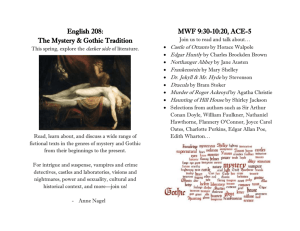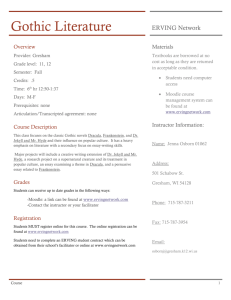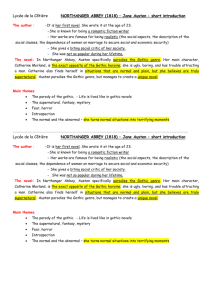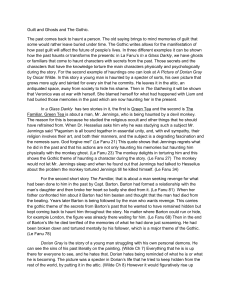Gothic Wider Reading Texts
advertisement
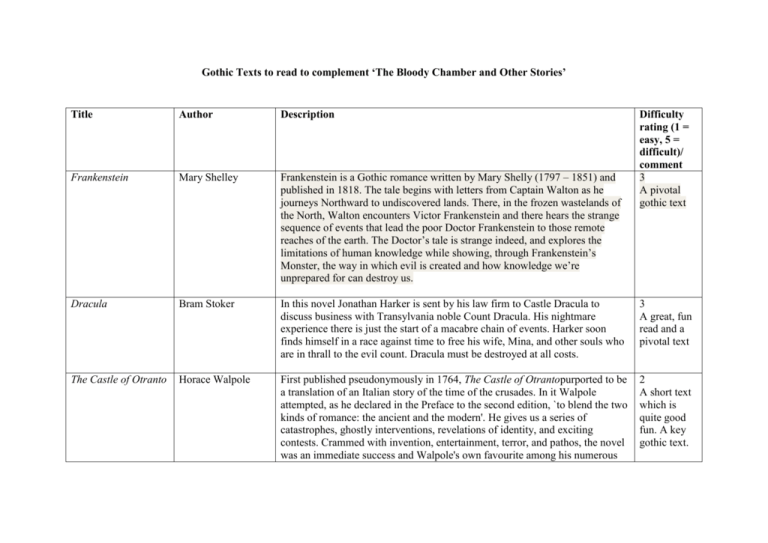
Gothic Texts to read to complement ‘The Bloody Chamber and Other Stories’ Title Author Description Difficulty rating (1 = easy, 5 = difficult)/ comment 3 A pivotal gothic text Frankenstein Mary Shelley Frankenstein is a Gothic romance written by Mary Shelly (1797 – 1851) and published in 1818. The tale begins with letters from Captain Walton as he journeys Northward to undiscovered lands. There, in the frozen wastelands of the North, Walton encounters Victor Frankenstein and there hears the strange sequence of events that lead the poor Doctor Frankenstein to those remote reaches of the earth. The Doctor’s tale is strange indeed, and explores the limitations of human knowledge while showing, through Frankenstein’s Monster, the way in which evil is created and how knowledge we’re unprepared for can destroy us. Dracula Bram Stoker In this novel Jonathan Harker is sent by his law firm to Castle Dracula to discuss business with Transylvania noble Count Dracula. His nightmare experience there is just the start of a macabre chain of events. Harker soon finds himself in a race against time to free his wife, Mina, and other souls who are in thrall to the evil count. Dracula must be destroyed at all costs. 3 A great, fun read and a pivotal text The Castle of Otranto Horace Walpole First published pseudonymously in 1764, The Castle of Otrantopurported to be a translation of an Italian story of the time of the crusades. In it Walpole attempted, as he declared in the Preface to the second edition, `to blend the two kinds of romance: the ancient and the modern'. He gives us a series of catastrophes, ghostly interventions, revelations of identity, and exciting contests. Crammed with invention, entertainment, terror, and pathos, the novel was an immediate success and Walpole's own favourite among his numerous 2 A short text which is quite good fun. A key gothic text. works. His friend, the poet Thomas Gray, wrote that he and his family, having read Otranto, were now `afraid to go to bed o'nights'. Northanger Abbey Jane Austen Northanger Abbey is often referred to as Jane Austen’s “Gothic parody.” Decrepit castles, locked rooms, mysterious chests, cryptic notes, and tyrannical fathers give the story an uncanny air, but one with a decidedly satirical twist. The story’s unlikely heroine is Catherine Morland, a remarkably innocent seventeen-year-old woman from a country parsonage. While spending a few weeks in Bath with a family friend, Catherine meets and falls in love with Henry Tilney, who invites her to visit his family estate, Northanger Abbey. Once there, Catherine, a great reader of Gothic thrillers, lets the shadowy atmosphere of the old mansion fill her mind with terrible suspicions. What is the mystery surrounding the death of Henry’s mother? Is the family concealing a terrible secret within the elegant rooms of the Abbey? Can she trust Henry, or is he part of an evil conspiracy? Catherine finds dreadful portents in the most prosaic events, until Henry persuades her to see the peril in confusing life with art. 2/3 Fairly short – a fun parody of the gothic The Mystery of Udolpho Ann Radcliffe With The Mysteries of Udolpho, Ann Radcliffe raised the Gothic romance to a new level and inspired a long line of imitators. Portraying her heroine's inner life, creating a thick atmosphere of fear, and providing a gripping plot that continues to thrill readers today, The Mysteries of Udolpho is the story of orphan Emily St. Aubert, who finds herself separated from the man she loves and confined within the medieval castle of her aunt's new husband, Montoni. Inside the castle, she must cope with an unwanted suitor, Montoni's threats, and the wild imaginings and terrors that threaten to overwhelm her. 3/4 Chunky but with good gothic elements Wuthering Heights Emily Bronte Wuthering Heights is a wild, passionate story of the intense and almost demonic love between Catherine Earnshaw and Heathcliff, a foundling adopted by Catherine's father. After Mr Earnshaw's death, Heathcliff is bullied and humiliated by Catherine's brother Hindley and wrongly believing that his love for Catherine is not reciprocated, leaves Wuthering Heights, only to return 3 A seminal text with an interesting narrative years later as a wealthy and polished man. He proceeds to exact a terrible revenge for his former miseries. The action of the story is chaotic and unremittingly violent, but the accomplished handling of a complex structure, the evocative descriptions of the lonely moorland setting and the poetic grandeur of vision combine to make this unique novel a masterpiece of English literature. structure. Very passionate and romantic. The Woman in Black Susan Hill Set on the obligatory English moor, on an isolated causeway, the story has as its hero Arthur Kipps, an up-and-coming young solicitor who has come north from London to attend the funeral and settle the affairs of Mrs. Alice Drablow of Eel Marsh House. The routine formalities he anticipates give way to a tumble of events and secrets more sinister and terrifying than any nightmare: the rocking chair in the deserted nursery, the eerie sound of a pony and trap, a child's scream in the fog, and most dreadfully--and for Kipps most tragically-The Woman In Black. 2 You’ve seen the film; now read the book! The Picture of Dorian Gray Oscar Wilde Written in his distinctively dazzling manner, Oscar Wilde’s story of a fashionable young man who sells his soul for eternal youth and beauty is the author’s most popular work. The tale of Dorian Gray’s moral disintegration caused a scandal when it first appeared in 1890, but though Wilde was attacked for the novel’s corrupting influence, he responded that there is, in fact, “a terrible moral in Dorian Gray.” Just a few years later, the book and the aesthetic/moral dilemma it presented became issues in the trials occasioned by Wilde’s homosexual liaisons, which resulted in his imprisonment. Of Dorian Gray’s relationship to autobiography, Wilde noted in a letter, “Basil Hallward is what I think I am: Lord Henry what the world thinks me: Dorian what I would like to be—in other ages, perhaps.” Rebecca Daphne du Maurier The novel begins in Monte Carlo, where our heroine is swept off her feet by the dashing widower Maxim de Winter and his sudden proposal of marriage. Orphaned and working as a lady's maid, she can barely believe her luck. It is only when they arrive at his massive country estate that she realizes how large 3 You will be doing this at A2 so if you want to get a head start… however, this does not mean you won’t have to read it again! 2/3 Long but easy reading and a shadow his late wife will cast over their lives--presenting her with a lingering evil that threatens to destroy their marriage from beyond the grave. First published in 1938, this classic gothic novel is such a compelling read that it won the Anthony Award for Best Novel of the Century. Carmilla J.S Le Fanu Carmilla is a Gothic novella and one of the early works of vampire fiction. It was first published in 1871 as a serial narrative in The Dark Blue. It tells the story of a young woman's susceptibility to the attentions of a female vampire named Carmilla. It predates Bram Stoker's Dracula by 26 years. The story has been adapted many times in film and other media. The Hunchback of Notre Dame Victor Hugo In the vaulted Gothic towers of Notre-Dame lives Quasimodo, the hunchbacked bellringer. Mocked and shunned for his appearance, he is pitied only by Esmerelda, a beautiful gypsy dancer to whom he becomes completely devoted. Esmerelda, however, has also attracted the attention of the sinister archdeacon Claude Frollo, and when she rejects his lecherous approaches, Frollo hatches a plot to destroy her that only Quasimodo can prevent. Victor Hugo's sensational, evocative novel brings life to the medieval Paris he loved, and mourns its passing in one of the greatest historical romances of the nineteenth century. The Raven and short stories Edgar Allen Poe It's late. The poem's speaker is tired and weak, reading an old collection of folklore (note that Ravens are prevalent in folklore). As he's about to fall asleep, he hears something tapping at his door. The speaker, somewhat startled, consoles himself by muttering "tis some visitor" and "nothing more." The narrator returns to his chamber and soon hears a louder tapping, this time at his window. He decides to explore the noise, telling himself it is merely the wind. The narrator opens the shutter and a raven flies in. The narrator opens the shutter and a raven flies in and keeps coming back reciting ‘nevermore…’ atmospheric. It will keep you on the edge of your seat all the way through! 2 Short and fun. 2 The Raven is a poem so it’s short(ish). The Masque of the Red Death Edgar Allen Poe In 'The Masque of the Red Death'and other tales of Gothic horror, Edgar Allan Poe writes as no one else ever has of creeping, mounting terrors - of the deadly approach of a terrible pendulum, of the awful end of an ancient and noble house, and of the impossible beating of a dead heart. The Phantom of the Opera Gaston Leroux First published in French as a serial in 1909, "The Phantom of the Opera" is a riveting story that revolves around the young, Swedish Christine Daaé. Her father, a famous musician, dies, and she is raised in the Paris Opera House with his dying promise of a protective angel of music to guide her. After a time at the opera house, she begins hearing a voice, who eventually teaches her how to sing beautifully. All goes well until Christine's childhood friend Raoul comes to visit his parents, who are patrons of the opera, and he sees Christine when she begins successfully singing on the stage. The voice, who is the deformed, murderous 'ghost' of the opera house named Erik, however, grows violent in his terrible jealousy, until Christine suddenly disappears. The phantom is in love, but it can only spell disaster. Leroux's work, with characters ranging from the spoiled prima donna Carlotta to the mysterious Persian from Erik's past, has been immortalized by memorable adaptations. Despite this, it remains a remarkable piece of Gothic horror literature in and of itself, deeper and darker than any version that follows. The Little Stranger Sarah Waters The Little Stranger follows the strange adventures of Dr. Faraday, the son of a maid who has built a life of quiet respectability as a country doctor. One dusty postwar summer in his home of rural Warwickshire, he is called to a patient at Hundreds Hall. Home to the Ayres family for more than two centuries, the Georgian house, once grand and handsome, is now in decline-its masonry crumbling, its gardens choked with weeds, the clock in its stable yard permanently fixed at twenty to nine. But are the Ayreses haunted by something more ominous than a dying way of life? Little does Dr. Faraday know how closely, and how terrifyingly, their story is about to become entwined with his. 2 Long but simple. Sarah Waters is a fabulous modern author. The Legend of Sleepy Hollow Washington Irving The story of Ichabod Crane and his hapless attempt to win the heart and hand of Katrina Van Tassel in the context of a comical ghost story. Ichabod comes to Sleepy Hollow, New York, from his home state of Connecticut, to be the schoolmaster of the village. Sleepy Hollow is a small, very quiet town said to be under some kind of enchantment. Its residents all seem to move a little slower, daydream a little more, and be more prone to believe in the supernatural. Sleepy Hollow, maybe for that reason or maybe because its residents are almost all descended from its original Dutch settlers, has more than its fair share of supernatural occurrences, or at least stories of them. The Turn of the Screw Henry James A very young woman's first job: governess for two weirdly beautiful, strangely distant, oddly silent children, Miles and Flora, at a forlorn estate...An estate haunted by a beckoning evil. Half-seen figures who glare from dark towers and dusty windows- silent, foul phantoms who, day by day, night by night, come closer, ever closer. With growing horror, the helpless governess realizes the fiendish creatures want the children, seeking to corrupt their bodies, possess their minds, own their souls... 4 Seriously creepy with some slightly challenging language. The Canterville Ghost Oscar Wilde This is Oscar Wilde's tale of the American family moved into a British mansion, Canterville Chase, much to the annoyance its tired ghost. The family -- which refuses to believe in him -- is in Wilde's way a commentary on the British nobility of the day -- and on the Americans, too. The tale, like many of Wilde's, is rich with allusion, but ends as sentimental romance. 2 Very short!

